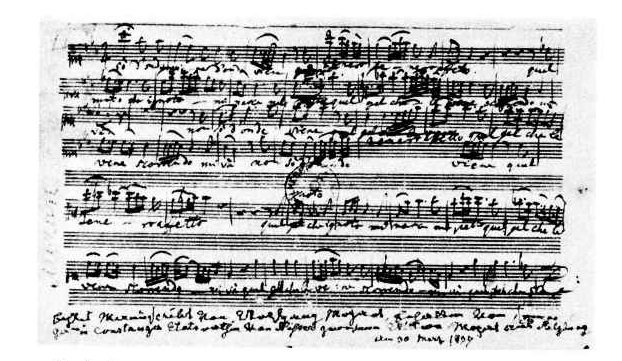Aria for soprano, two violins, viola and basso; composed for Aloysia Lange. Mozart’s autograph, in the Stadtarchiv, Hannover, is headed ‘di Amadeo Wolfgango Mozart mpr. per la Sigra. Weber à Mannheim il 24 di Febro 1778’. A leaf with an ornamented voice part survives in the library of the Bibliothèque nationale, Paris; an additional autograph leaf with the vocal part is in the Stadtarchiv, Braunschweig. The text derives from act III, scene 6 of Metastasio’s L’Olimpiade:
| Alcandro, lo confesso, | Alcandro, I confess it, | |
| Stupisco di me stesso. | I am astonished at myself. | |
| II volto, il ciglio, | His countenance, his gaze, | |
| La voce di costui nel cor mi desta | his voice: they awaken in my heart | |
| Un palpito improvviso, | a sudden trembling | |
| Che le risente in ogni fibra il sangue. | that I feel in every fibre of my blood. | |
| ... | ... | |
| Fra tutti i miei pensieri | I search for the cause in my thoughts, | |
| La cagion ne ricerco, e non la trovo. | and cannot find it. | |
| Che sarà, giusti Dei, questo ch'io provo? | Great gods, what is this I am about to undertake? | |
| ... | ... | |
| Non so d'onde viene | I do not know from whence comes | |
| Quel tenero affetto, | That tender affection, | |
| Quel moto che ignoto | that vibration | |
| Mi nasce nel petto, | which is born in my breast, | |
| Quel giel, che le vene | That ice which flows | |
| Scorrendo mi va. | throughout my veins. | |
| ... | ... | |
| Nel seno destarmi | To me it does not seem | |
| Sì fieri contrasti | that mere pity | |
| Non parmi che basti | can possibly awake my heart | |
| La sola Pietà. | to such fierce conflict. |

W. A. Mozart, autograph vocal ornaments for ‘Alcandro lo confesso— Non sò d’onde’ K294 (Paris, Bibliothèque nationale)
Mozart knew in particular a setting of the text by Johann Christian Bach performed as part of a pasticcio in London in 1769. His acquaintance with Bach’s version, and the history of his own setting, is documented in a letter of 28 February 1778:
- . . . I like an aria to fit a singer as perfectly as a well-made suit of clothes. For practice I have also set to music the aria ‘Non so d’onde viene’ etc. which has been so beautifully composed by Bach. Just because I know Bach’s setting so well and like it so much, and because it is always ringing in my ears, I wished to try and see whether in spite of all this I could not write an aria totally unlike his. And, indeed, mine does not resemble his in the very least. At first I had intended it for Raaff; but the beginning seemed to me too high for his voice. Yet I liked it so much that I would not alter it; and from the orchestral accompaniment too it seemed to me better suited to a soprano. So I decided to write it for Mlle Weber.
Mozart’s ornaments to the vocal part documented by the Paris manuscript date from 1783 and are first mentioned in his letter of 12 April of that year: ‘I am sorry to say that the mail coach does not leave until this day week, so I cannot send you the two copies of my sonatas [K296+K376-380] until then. But you shall also have the voice part with variations of the aria 'Non so d’onde viene.’ In the event, Mozart did not send the ornaments until 21 May (letter of that date).